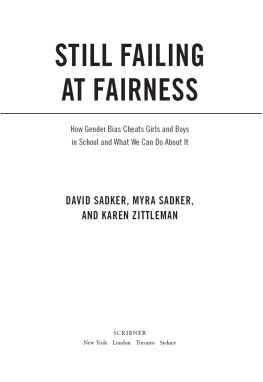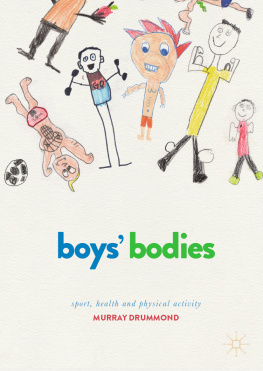Uncertain Masculinities
In this era of rapid change, boys face more difficulties than ever before in establishing their self-image and status. In this original and challenging study Mike ODonnell and Sue Sharpe explore how teenage boys from white, African-Caribbean and Asian backgrounds negotiate contemporary uncertainties to construct their gender identities.
Drawing on theoretical insights about how class, race and ethnicity critically affect the formulation of masculinities, the authors examine:
- the split between boys formal acceptance of politically correct ideas and their informal behaviour amongst the peer group
- boys leisure pursuits, including involvement in illegal activities and their selective identification with global youth culture
- the discrepancies between boys and girls attitudes and expectations
- the quality of communication and guidance between men and boys
Uncertain Masculinities is a fascinating account of the complexity of contemporary boys identities and will be of use to students of the sociology of youth and of gender studies.
Mike ODonnell is a Senior Lecturer in sociology at the University of Westminster. Sue Sharpe is Visiting Fellow at the Social Science Research Unit, Institute of Education, and the author of Just Like a Girl.
Uncertain Masculinities
Youth, ethnicity and class in contemporary Britain
Mike ODonnell and Sue Sharpe
First published 2000
by Routledge
11 New Fetter Lane, London EC4P 4EE
Simultaneously published in the USA and Canada
by Routledge
29 West 35th Street, New York, NY 10001
Routledge is an imprint of the Taylor & Francis Group
This edition published in the Taylor & Francis e-Library, 2003.
2000 Mike ODonnell and Sue Sharpe
All rights reserved. No part of this book may be reprinted or reproduced or utilised in any form or by any electronic, mechanical, or other means, now known or hereafter invented, including photocopying and recording, or in any information storage or retrieval system, without permission in writing from the publishers.
British Library Cataloguing in Publication Data
A catalogue record for this book is available from the British Library
Library of Congress Cataloging-in-Publication Data
ODonnell, Mike.
Uncertain masculinities: youth, ethnicity and class in contemporary Britain
Mike ODonnell and Sue Sharpe
Includes bibliographical references and index.
1. Teenage boysEnglandLondonsocial conditions.
2. Minority teenagersEnglandLondonsocial conditions. 3.
MasculinityEnglandLondon.
4. SocialisationEnglandLondon. 5. Ethnicity
EnglandLondon. 6. Social surveysEnglandLondon.
I. Sharpe, Sue, 1945II. Title.
HQ799.E52 L656 2000
305.23509421dc21 00022263
ISBN 0-203-44283-0 Master e-book ISBN
ISBN 0-203-75107-8 (Adobe eReader Format)
ISBN 0-415-15346-8 (hbk)
ISBN 0-415-15347-6 (pbk)
To our respective Dads now gone always remembered
Introduction
In 1999 Jack Straw, then Home Secretary, was prominently reported as saying that the main social issue of our time pertained to the behaviour and role of young men. He was doing no more than giving official recognition to a concern that had been repeatedly expressed throughout the 1980s and increasingly during the 1990s. On the face of it there certainly seems to be a boys problem. Boys are now under-performing compared to girls in nearly all subjects at GCSE; the less well qualified can be difficult to employ and as a result often struggle to construct stable and fulfilling lives; boys commit about three times as much crime as girls; and they are generally perceived as far more anti-social in their general conduct than girls. Much of the damage they do is to themselves. Boys are far more likely to attack each other than to attack girls, and the suicide rate for young men between the ages of 15 and 24 has almost doubled since 1976 and is far higher than the corresponding figure for young women. The image of young men is now so poor that they are often presented in the popular media as a dubious risk as partners for young women.
How fair is this perception of boys as being not only more difficult than girls but as somehow also being in greater difficulty? We decided to explore these and related issues for ourselves. Talking with an ethnically diverse sample of boys has provided the information that drives this book. What they told ussometimes intentionally and sometimes by implicationwas by no means always predictable. Although our research confirms some widely held views of boys in contemporary society, their accounts testify to the complexity and difference in their situations. Class and ethnicity interplay with gender and generation to an extent that tends to undermine sweeping generalisations. At the core of this book are the boys themselvestheir responses and accounts; but we have not fought shy of making our own interpretations. However, rather than overburden our account with theory we have only drawn on and constructed theory where it is helpful in making sense of our data.
Uncertain Masculinities is based on research we carried out in four London schools, mainly in the mid-1990s. We conducted the survey through questionnaires and interviews. The questionnaires were completed by 262 boys, and we interviewed 44 of these. We also interviewed three senior staff from the schools. We sought to report the boys thoughts on a number of key areas of their lives. These areas are indicated in the chapter titles. The main focus of the book is on the way the boys attitudes are gendered, and, in particular, how they come to think and behave as masculine. A basis of gender comparison was already available from Sue Sharpes studies of girl students (Just Like a Girl, 1976 and 1994) at four Ealing schools, three of which were included in the present survey. We also included a school from Hackney in East London. All the boys in our research were in year eleven, and most were 15 or 16 years old. This was a year older than the girls in Sharpes studies. We wanted to allow for the tendency for boys to mature physically and mentally somewhat later than girls, and we found that, if anything, a year was an underestimate, although some of the boys relative immaturity was explicable in cultural rather than maturational terms. The inclusion of the Hackney school boosted the number of African-Caribbean boys in the survey and also increased the number of boys from smaller minority ethnic groups. By far the largest groups in the survey were white (a large majority born in England), African-Caribbean and Asian (mainly Indian and Pakistani). One of the Ealing schools had a large majority of Asian students (mainly Sikh and Muslim). The real names of boys or teachers quoted in the book have all been changed.
The construction of gender in relation to class, ethnicity and age
While gender relations and the construction of masculinities are the main themes of this book, ethnicity, class and age also loom large. Class and ethnicity are widely acknowledged as major influences on the formation of masculinities. Paul Williss classic Learning to Labour (1977) shows how a group of working class boys become men by imitating the toughness, solidarity and physicality which they associate with their fathers. It is resentment of and even resistance against them, against authority, that is the basis of their macho character. Less studied than working-class masculinity are the masculinities of middle and upper-class men and boys. A still far-from-extinct example of the latter are the public school type, who, in contrast to working-class men and boys, typically internalise the belief that it is their peculiar right to exercise authority. Both working-class and upper-class men embody their distinctive masculinities in their differing demeanour, style and use of language. Both these types of masculinity embody expressions of gender inequality, in the form of real or implied dominance, in relation to women and girls.









